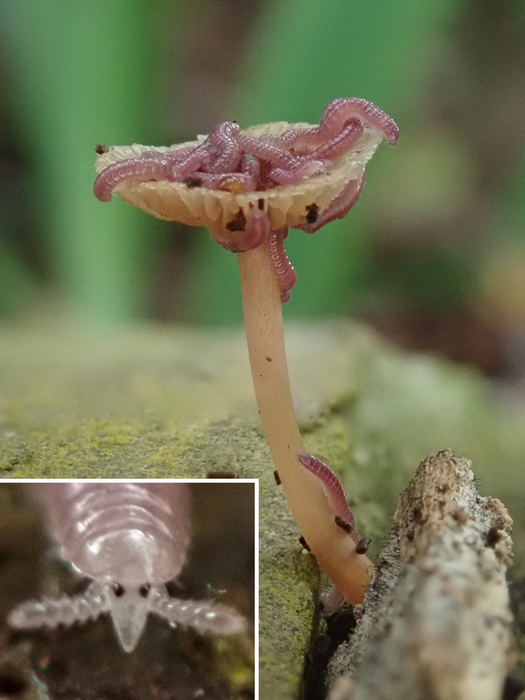Whether nectar-sucking butterflies or blood-sucking mosquitoes – the ingestion of liquid food has long been known for many insects and other arthropods. A research team from Germany and Switzerland, led by the Leibniz Institute for the Analysis of Biodiversity Change (LIB) and the University of Bonn, now shows that millipedes also use a sucking pump to ingest liquid food. A sucking pump has thus evolved independently in different groups of organisms over several 100 million years. In the process, astonishingly similar biomechanical solutions for ingesting liquid food have evolved in widely distant animal groups. The study results have now been published in the journal Science Advances.

Credit: Image: Leif Moritz
Whether nectar-sucking butterflies or blood-sucking mosquitoes – the ingestion of liquid food has long been known for many insects and other arthropods. A research team from Germany and Switzerland, led by the Leibniz Institute for the Analysis of Biodiversity Change (LIB) and the University of Bonn, now shows that millipedes also use a sucking pump to ingest liquid food. A sucking pump has thus evolved independently in different groups of organisms over several 100 million years. In the process, astonishingly similar biomechanical solutions for ingesting liquid food have evolved in widely distant animal groups. The study results have now been published in the journal Science Advances.
Like insects, crustaceans and arachnids, millipedes belong to the megadiverse group of arthropods. While liquid-based diets have been for insects and arachnids, it was previously only suspected that some millipedes also feed on liquid food. A team led by scientists Leif Moritz (Leibniz Institute for the Analysis of Biodiversity Change, University of Bonn), Dr. Thomas Wesener (Leibniz Institute for the Analysis of Biodiversity Change) and Prof. Dr. Alexander Blanke (University of Bonn) now studied the heads of representatives of the species-poor and exotic Colobognatha.
Using high-resolution tomography as well as histological methods and electron microscopy, the researchers discovered a sucking pump in millipedes that is strikingly similar to those of insects. It consists of a chamber that is widened by strong muscles to suck in liquid food. “Together with the protractible mouthparts the sucking pump enables these millipedes to ingest more or less liquid food,” explains Leif Moritz, a doctoral student at the University of Bonn and the LIB.
The research team was thus able to show that the functional tools for a diet with liquid nutrients have evolved several times independently in all major subgroups of arthropods. “The biomechanical-morphological similarities between the groups of organisms indicate the strength of selection as soon as a food source provides even a slight evolutionary advantage,” elaborates Alexander Blanke head of the working group for evolutionary morphology at the University of Bonn.
The study also provides insights to better understand the origin of species diversity. This is because, in contrast to the very species-rich sucking insects with over 400,000 species, the group of Colobognatha millipedes comprises only about 250 species. “Consequently, liquid-based feeding alone is not a general driver of species richness,” adds Thomas Wesener, head of the Myriapoda section at LIB. Because these millipedes mostly rely on moist habitats and cannot fly, their dispersal options appear limited, and they are more vulnerable to environmental change. “Today’s sucking millipedes are probably a relict group and the remnant of a once much larger diversity,” Alexander Blanke assumes.
Participating institutions and funding:
In addition to the Leibniz Institute for the Analysis of Biodiversity Change (LIB), Zoological Research Museum Alexander Koenig, and the Institute of Evolutionary Biology and Animal Ecology at the University of Bonn, the Paul Scherrer Institute in Villigen (Switzerland) and the Helmholtz Centre hereon in Geesthacht are involved in the study. The project was funded by the German Research Foundation (DFG), the European Research Council (ERC) and the National Science Foundation of the United States (NSF).
Publication: Moritz L., Borisova E., Hammel J.U., Blanke A., Wesener T.: A previously unknown feeding mode in millipedes and the convergence of fluid feeding across arthropods, Science Advances, DOI: 10.1126/sciadv.abm0577
Contact:
Leif Moritz
Section Myriapoda
Leibniz Institute for the Analysis of Biodiversity Change (LIB)
Phone +49 228 9122-423
E-mail: [email protected]
Dr. Thomas Wesener
Head of Section Myriapoda, LIB Bonn
Phone +49 228 9122-425
E-mail: [email protected]
Prof. Dr. Alexander Blanke
Institute of Evolutionary Biology and Ecology, University of Bonn
Phone + 49 228 73 5130
E-mail: [email protected]
Journal
Science Advances
DOI
10.1126/sciadv.abm0577
Method of Research
Observational study
Subject of Research
Animals
Article Title
A previously unknown feeding mode in millipedes and the convergence of fluid feeding across arthropods
Article Publication Date
16-Feb-2022




